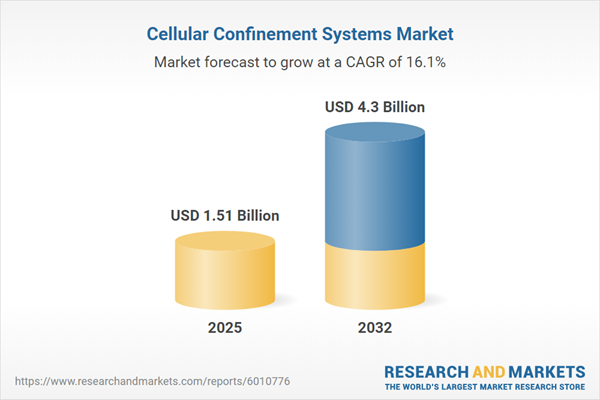Speak directly to the analyst to clarify any post sales queries you may have.
Cellular confinement systems are gaining significant traction among senior decision-makers tasked with advancing infrastructure resilience, regulatory compliance, and operational efficiency. These solutions are central to future-focused strategies, enabling robust ground stabilization and supporting organizations’ drive for sustainable, reliable infrastructure in an evolving regulatory landscape.
Market Snapshot: Cellular Confinement Systems
In 2024, the global market for cellular confinement systems was valued at USD 1.30 billion due to sustained investment in infrastructure by both public and private entities and heightened attention to environmental considerations. The market is forecast to expand swiftly with a projected compound annual growth rate of 16.11% through 2032, ultimately reaching USD 4.30 billion. Contributing factors include closer industry partnerships, advances in technology, streamlined installation, and a sector-wide push for more sustainable infrastructure. As adoption broadens, companies are updating procurement and operational strategies to embed these systems within broader sustainability frameworks and respond to shifting compliance and operational expectations.
Scope & Segmentation of Cellular Confinement Systems
- Material Types: High-density polyethylene, polypropylene, and polyvinyl chloride are chosen for their chemical resistance and durability, offering reliability in varying or harsh conditions.
- Installation Methods: On-site fabrication or prefabricated panels help match specific site requirements and enhance scheduling, useful for projects with tight timelines or changing criteria.
- Applications: Areas of use include slope stabilization, industrial load support, reinforcement of transport corridors, retaining structures, erosion control, and environmental remediation, each contributing to extended infrastructure lifespan and risk mitigation.
- End Use Industries: Primary sectors using these solutions are agriculture, civil construction, mining, utilities, and transportation. These industries face ongoing performance and environmental compliance demands, making advanced ground stabilization necessary.
- Regional Coverage: Adoption is robust across the Americas, Europe, Middle East, Africa, and Asia-Pacific. Leading activity is noted in the United States, Germany, China, India, and Brazil. Demand is shaped by diverse regulatory and climate-driven requirements, with regional customization meeting local needs, including focused strategies in the Middle East and Africa.
- Leading Companies: Presto Geosystems, PRS Geo-Technologies, Geo Products LLC, Ecoweb GeoCellular Synthetics, Hanes Geo Components, Carthage Mills, AgTec LLC, Soleno Inc., Groundtrax Systems, and Cell-Tek Geosynthetics drive sector innovation, investing in R&D and collaborative market approaches.
Key Takeaways for Senior Decision-Makers
- Cellular confinement systems enable infrastructure reliability by anchoring project stability and helping organizations adapt to changing compliance landscapes.
- Enhancements in polymers and digital monitoring technologies unlock improved efficiencies, facilitating smarter asset management and operational control across portfolios.
- Strategic procurement sourcing, with an emphasis on resilient supply partnerships, supports organizations in maintaining compliance and industry competitiveness across regions.
- Governance, risk oversight, and large-scale project delivery increasingly depend on refined compliance practices and stakeholder assurance measures.
- System customization bolsters adaptability, giving project teams flexibility to address distinct geographic, climatic, and regulatory environments.
Tariff Impact and Cost Dynamics
Forthcoming U.S. tariffs in 2025 have prompted organizations to revisit sourcing strategies and bolster domestic supply. Proactive investments in local production, paired with agile procurement and budget planning, equip procurement teams to navigate input cost volatility and fluctuating contract terms, supporting reliable project delivery and global market competitiveness.
Methodology & Data Sources
This analysis integrates interviews with technical experts, proprietary insights from engineering and manufacturing consultancies, and a detailed review of segment, compliance, and technical data. These sources inform senior decision-makers managing complex regulatory and operational requirements.
Why This Report Matters
- Delivers actionable intelligence for procurement and investment planning in ground stabilization projects through comprehensive technical and regulatory review.
- Enables organizations to anticipate trends in supply chain structures and costs, with current, market-driven analysis tailored to shifting sector dynamics.
- Supports leadership teams in identifying new commercial opportunities with clear insights into technology uptake and evolving geographic demand drivers.
Conclusion
Adopting cellular confinement systems increases infrastructure flexibility and compliance responsiveness. Their integration helps organizations address emerging project and regulatory needs, underpinning strategies for sustainable and agile infrastructure development in today’s complex markets.
Additional Product Information:
- Purchase of this report includes 1 year online access with quarterly updates.
- This report can be updated on request. Please contact our Customer Experience team using the Ask a Question widget on our website.
Table of Contents
3. Executive Summary
4. Market Overview
7. Cumulative Impact of Artificial Intelligence 2025
Companies Mentioned
The companies profiled in this Cellular Confinement Systems market report include:- Presto Geosystems
- PRS Geo-Technologies
- Geo Products, LLC
- Ecoweb GeoCellular Synthetics Co., Ltd.
- Hanes Geo Components
- Carthage Mills
- AgTec LLC
- Soleno, Inc.
- Groundtrax Systems Ltd
- Cell-Tek Geosynthetics
Table Information
| Report Attribute | Details |
|---|---|
| No. of Pages | 189 |
| Published | October 2025 |
| Forecast Period | 2025 - 2032 |
| Estimated Market Value ( USD | $ 1.51 Billion |
| Forecasted Market Value ( USD | $ 4.3 Billion |
| Compound Annual Growth Rate | 16.1% |
| Regions Covered | Global |
| No. of Companies Mentioned | 11 |









